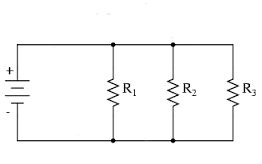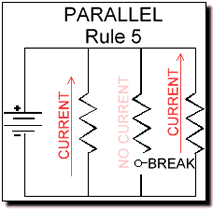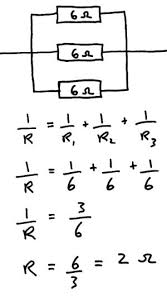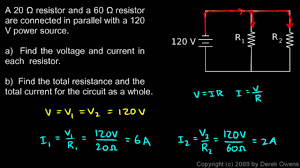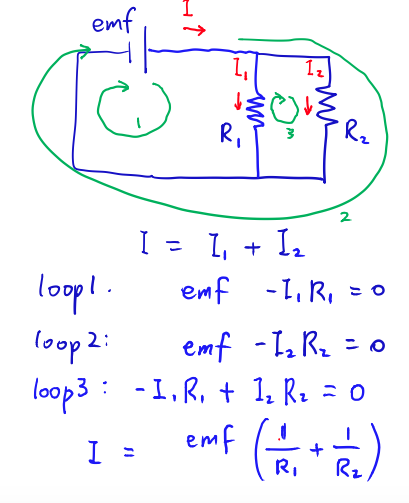Parallel CIrcuits
Claimed by Trevor Craport
This page covers one of the two types of basic circuits covered in this course, Parallel Circuits.
The Main Idea
Parallel circuits are a type of circuit that are composed of multiple paths that the current can pass through. Each path is independent of one another and if one path were to go out, the others would still have current passing through them. There are five basic rules/characteristics for parallel circuits. These rules include: the current has two or more separate paths to travel through, the voltage is the same across every path in a parallel circuit, the sum of current through each path is equal to the total current that comes into and out of the circuit as a whole, total resistance is determined by the equation 1/Req = 1/R1 + 1/R2 + 1/R3 +1/Rn, and each path is independent of one another in that if one path were to go out, the values of current through each path would change, but would not go out like it would in series.
A Mathematical Model
For parallel circuits, there are a few equations that are necessary to know and understand so that you are able to solve for any missing part of a circuit problem.
Total resistance RT for resistors in parallel: 1/RT = 1/R1 + 1/R2 + 1/R3 + ...
Voltage is always the same across branches: VT = V1 = V2 = V3 = ...
Total current (Node rule) IT = I1 + I2 + I3 + ...
Ohm's Law: V = IR
Each of these equations are useful in deterring select aspects of parallel circuits that may be missing in problems related to this topic. Each problem starts with the loop rule, node rule, and Ohm's law to define any variable given so that additional variables and components of the circuit can be identified and calculated.
Examples
Below are three levels of examples. While all contain only Resistors and one battery, it is important to understand that capacitors, multiple batteries, and potentially inductors that effect current flow and charge through the entire circuit.
Simple
This example is a basic problem of calculating total resistance looking at three resistors in parallel. Using the resistance formula from above, we know that 1/Req = 1/R1 + 1/R2 + 1/R3. From there, we plug in the known values of the three resistors and solve for Req. This value comes to 2 ohms. To further expand on this calculation, having these three 6 ohm restores in parallel is equivalent to having one 2 ohm resistor in series alone.
Middling
This example takes our calculations one step further than the first example. While it is important to be able to calculate the total resistance in a parallel circuit, there are other variables of the circuit to calculate. First, part a of the question asks to find the voltage and current in each resistor. For the voltage, we know that VT = V1 = V2 and because the VT from the battery is equal to 120 V, the voltage across each resistor is equal to that same 120V. To find the currents across each resistor, you use Ohm's Law (V = IR) for each resistor to find the two separate currents as shown in the diagram. Finally, for part b of the question, using the node rule, we can add the two separate currents across the two resistors to get the total current of the circuit. From there, there are two ways to find the total resistance, you can either repeat what was done in the simple example, or use ohm's law again with the total voltage and total current values to find the total resistance.The important concept to take away from this example is that there is not one clear path to solving these problems. if you understand all of the formulas, there are multiple correct ways to get the answer that you are looking for.
Difficult
While this, again, is a more simple circuit, the thing that makes this a more difficult example is the absence of any known variables or numbers for the circuit. By using the loop rule, we can find a plethora of different variables if we so choose. For this specific example, the goal is to determine the total current in the circuit. To do this, you construct three separate potential difference loops that can then be placed to together to solve for the total current.
Connectedness
Parallel circuits are in things that we use in everyday society. Our society has become so technologically advanced and sophisticated and it all started from simple ideas like the first parallel circuits shown above. It connects to everyday lighting and electronic use in our homes and other establishments as well as some novelties like christmas lights or other electronic toys. My major, Biology, has very little related to circuits and electricity; however, without it, several of the instruments and equipment used on a daily basis in labs and other research opportunities. Circuits and electricity are fascinating phenomenons that drive our society and without them, much of the technology we see today would not exist.
History
Ever since electricity was first discovered, many other properties and characteristics of how electricity flows have been discovered. Parallel circuits are considered one of those extensions and these types of circuits are used in everyday things like christmas lights and house electrical configurations too.
See also
Parallel Circuits are just one component of the total circuit composition. In this physics book page, there are further extensions on the other basic type of circuit as well as many variations in laws that originate from them.
http://www.physicsbook.gatech.edu/Series_Circuits
http://www.physicsbook.gatech.edu/Parallel_Circuits_vs._Series_Circuits*
http://www.physicsbook.gatech.edu/Loop_Rule
http://www.physicsbook.gatech.edu/Node_Rule
External links
http://www.wikihow.com/Solve-Parallel-Circuits
References
https://www.swtc.edu/Ag_Power/electrical/lecture/parallel_circuits.htm
http://www.physicsclassroom.com/class/circuits/Lesson-4/Parallel-Circuits
Professor Kim's lecture on Loop rule of parallel circuits
